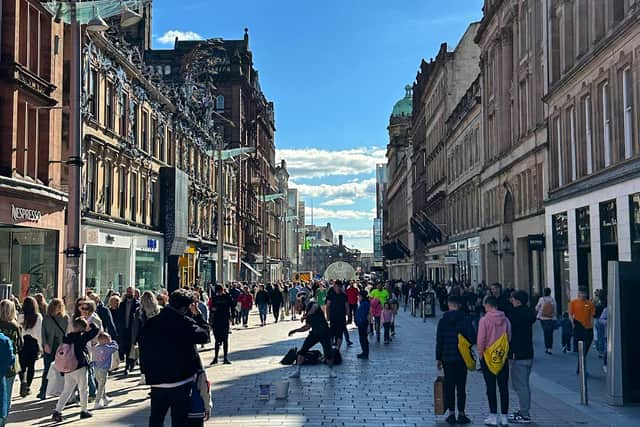New figures suggest food and drink is driving Glasgow city centre recovery
and live on Freeview channel 276
New figures revealed weekend and night-time footfall is above pre-pandemic levels.
The number of people visiting Glasgow city centre on a weekday “remains an issue” — but sales are increasing.
Advertisement
Hide AdAdvertisement
Hide AdA council report revealed that while traditional retail was still struggling, food and drink outlets saw sales in December last year up 15% on 2019.
Work to boost the city centre is being carried out under a recovery plan, and has so far included additional graffiti removal, enhanced cleansing and more community enforcement officer patrols.


Cllr Angus Millar, convener for city centre recovery, said: “The plan was put in place to help guide the area’s post-pandemic recovery, and has helped deliver support for businesses operating there and a range of other measures to attract visitors and boost the local economy, as well as considering in what ways the city centre will thrive in the future.”
Two reports on how to improve the city centre are expected to be complete next month and could lead to changes to planning policy.
Advertisement
Hide AdAdvertisement
Hide AdOne will focus on the “changing needs” for retail space while the other looks at regenerating the ‘Golden Z’ — Argyle, Buchanan and Sauchiehall Streets. It will encourage the re-use of vacant buildings.
Footfall in December was 18% below pre-covid levels — 814,000 fewer visitors to the city centre, the report reveals. Train strikes in mid-December are reported to have resulted in 112,000 fewer visitors compared to the previous week.
However, real-time figures show the city centre has now recovered further, with footfall up to 95% of 2019 levels over the last 30 days. Weekend and night-time footfall is above pre-covid levels.
The council report states weekday footfall “remains an issue with the slow return rate of officer workers to Glasgow city centre”.
Advertisement
Hide AdAdvertisement
Hide AdSales in Glasgow city centre were 15% ahead of December in 2019, the report reveals, and up 30% compared to December 2021.
Officials report: “Sales performance continues to follow previous trends where recovery is being led by food and drink (+54%) rather than traditional retail activity (i.e. general retail was 25% down).
“Although sales have increased, businesses are facing rising cost pressures so this does not necessarily translate to increased profitability.”
Six priority areas were identified for action under the recovery plan: Sauchiehall Street, Argyle Street, Anderston Cross, Buchanan Bus Station, Heilanman’s Umbrella, and High Street.
Advertisement
Hide AdAdvertisement
Hide AdWork has included “vinyls, hoarding and other improvement works” on “vacant units and strategic sites” on Sauchiehall and Argyle Street and “meanwhile use projects” are being developed for other areas, such as High Street.
A successful bidder has now been appointed to “reinvigorate the shopfronts at Heilanman’s Umbrella” and improvements to Anderston station are planned for summer, including an accessible lift, planting and lighting. Public realm around Buchanan Bus Station will also be improved.
Other measures carried out under the recovery plan include a Glasgow Loves Christmas campaign which “targeted the regional catchment which comprises the ‘everyday’ shopper” and a project to encourage visitors to use public transport.
A media campaign in June 2022 was also focused on promoting the city centre to over 40s. “This was assessed to have delivered significant reach with over 40% of adults in Glasgow having viewed the TV advert at least once, and approximately eight times on average.”
Advertisement
Hide AdAdvertisement
Hide AdGlasgow Life led a domestic tourism drive aimed at promoting winter events and overnight stays in the city in the lead up to Christmas and early 2023. Officials say the campaign was “extremely successful in terms of the results achieved”.
The report states: “Despite the pressures on Glasgow city centre over the period since March 2020, it can be acknowledged that while significant issues do remain, good progress overall has been made in terms of recovery.
However, it adds “one key issue is the city’s perceived low rate of office return” and work is underway to establish the accuracy of the data and whether “there are unique causes for Glasgow city centre”.
Cllr Millar described the recovery plan as “invaluable” and said he now looks “forward to working with partners as we develop a successor city centre strategy” for 2024 to 2030.
Comment Guidelines
National World encourages reader discussion on our stories. User feedback, insights and back-and-forth exchanges add a rich layer of context to reporting. Please review our Community Guidelines before commenting.